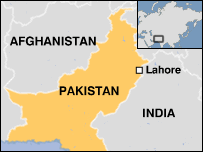
LAHORE, PAKISTAN, February 10, 2020 (Dawn): Despite being granted nominal religious freedom by Pakistan’s Constitution, Hindus like Raj Kumari, who has lived in Lahore since birth, still face extreme obstacles in being able to practice their faith. In a city of 11 million people that covers almost 2,000 square kilometers, only two publicly-functioning Hindu temples remain. One is the Krishna Mandir of Ravi Road, while the other is the Valmiki Mandir, located in New Anarkali. “We’re not allowed to abandon our religion,” Raj Kumari says. But living in Lahore has severely impacted their visibility and how they practice their faith in public spaces. In order to fully appreciate how the Krishna and Valmiki Mandirs operate today, one must understand them within the greater context of Lahore and its spatial politics, whose complex history dates back long before the state of Pakistan was established.
The foundation of Lahore and Pakistan at large – namely, the Two-Nation Theory – depends on an exclusive definition of space, ultimately leading to social cleansing and contestation over control of spatial politics and architectural language in Lahore. Lahore, as the already-developed political capital of several empires, was economically buttressed by the British Raj, becoming one of the largest and most advanced cities in the Indian subcontinent after the ascendance of the British Empire. However, the onset of Partition changed Lahore fundamentally.
The consequences for Lahore being demarcated as a part of Muslim Pakistan were colossal; thousands of Hindus and Sikhs fled their homes for India as Muslim rioters ravaged their properties and took their lives. As the Muslim population continues to grow exponentially, the city takes the form of a monolithic space, all the while curbing traces of other religions. In this process, a Lahore that was once home to rich cultural and ethnic diversity quickly becomes a thing of the past. As per anthropologist Haroon Khalid, the Lahore that is now marked by huge infrastructure and everyday hustle that stretches beyond midnight conceals the Lahore that exists in historical imaginations.





